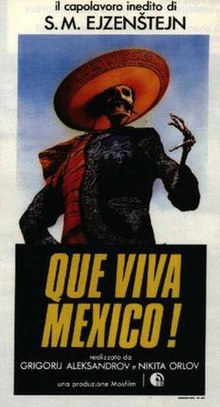¡Que viva México!
| ¡Que Viva México! - Da zdravstvuyet Meksika! | |
|---|---|

Italian poster
|
|
| Directed by | Sergei Eisenstein |
| Written by | Sergei Eisenstein (original screenplay) and Grigori Aleksandrov (additional material) |
| Narrated by | Sergei Bondarchuk |
| Distributed by | Mosfilm |
|
Release date
|
November 1979 (USA) |
|
Running time
|
90 minutes |
| Country | Soviet Union |
| Language | Russian |
¡Que viva México! (Russian: Да здравствует Мексика!) is a film project begun in 1930 by the Russian avant-garde director Sergei Eisenstein (1898–1948). It would have been an episodic portrayal of Mexican culture and politics from pre-Conquest civilization to the Mexican revolution. Production was beset by difficulties and was eventually abandoned. Jay Leyda and Zina Voynow call it his "greatest film plan and his greatest personal tragedy".
Eisenstein left for Mexico in December 1930—after various projects proposed by Charles Chaplin and Paramount Pictures fell through, and Paramount released him from his contract. The Mexican film was produced by Upton Sinclair and a small group of financiers recruited by his wife Mary Craig Kimbrough Sinclair, under a legal corporation these investors formed, the Mexican Film Trust. Their contract with Eisenstein called for a short, apolitical feature film about or involving Mexico, in a scenario to be designed and filmed by Eisenstein and his two compatriots, Grigori Alexandrov and Eduard Tisse. Other provisos of the contract, which Eisenstein signed on 24 November 1930, included that the film would be completed (including all post-production work) by April 1931, and would show or imply nothing that could be construed as insulting to or critical of post-Revolution Mexico (a condition imposed by the Mexican government before it would allow the three Soviets entry into their country). Filmed material was also to be subject to censorship by the Mexican government, at first after it was filmed and printed, later in 1931 during shooting via an on-site censor.
Eisenstein shot somewhere between 175,000 and 250,000 linear feet of film (30 to 50 hours) before the Mexican Film Trust stopped production, the Trust having run out of money and patience with Eisenstein's unwillingness/inability to complete the film expeditiously, and Eisenstein having received orders for his "speediest return" to the USSR from Soyuzkino, from which he had been absent since 1929. Although the original intent was for Eisenstein to proceed from Mexico to California and edit the film he had taken, he was not allowed to re-enter the United States by the Department of Immigration, nor later could any agreement be reached by the Trust with Soyuzkino which would have allowed the footage be sent to the USSR for completion by him there.
...
Wikipedia
